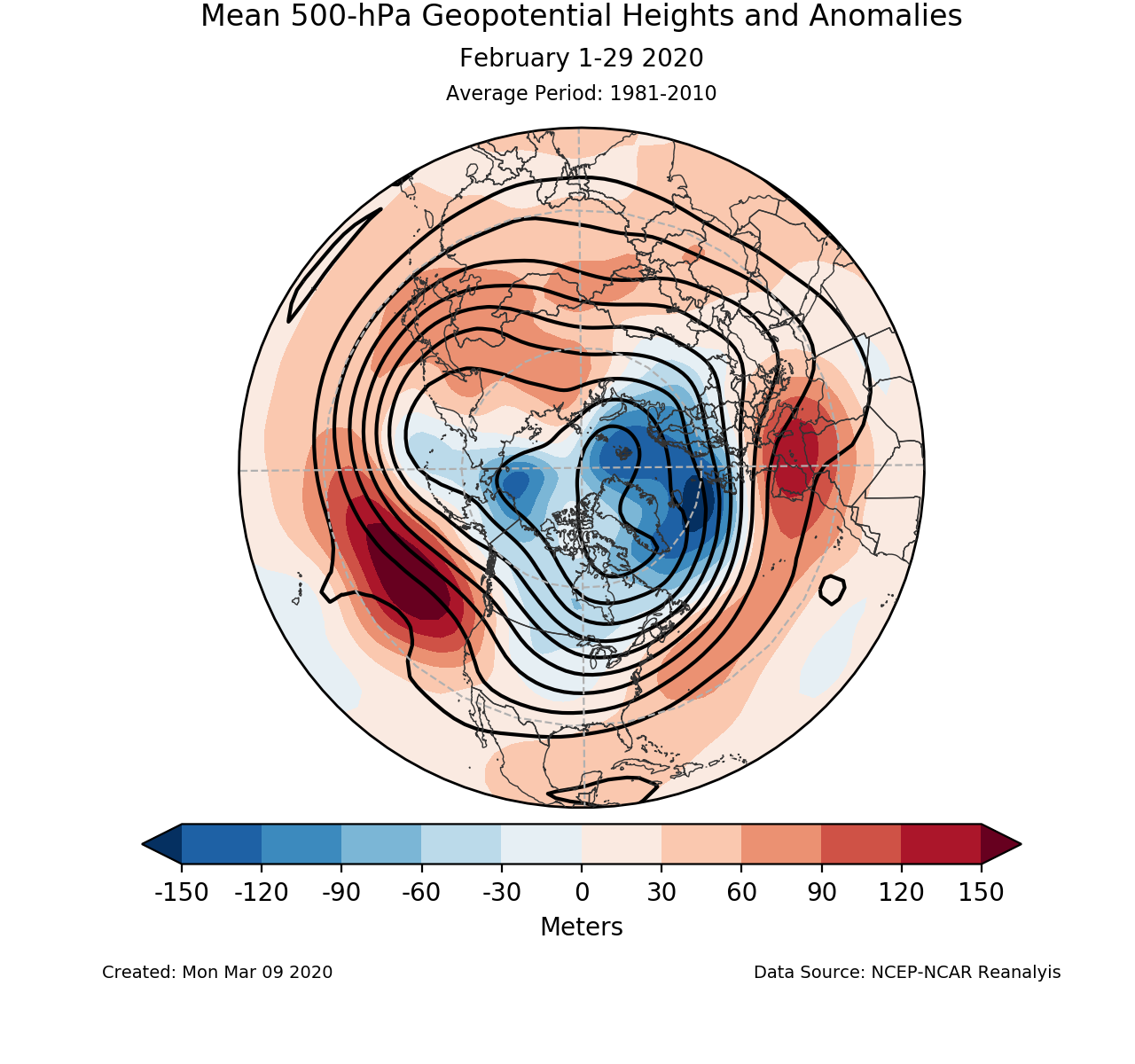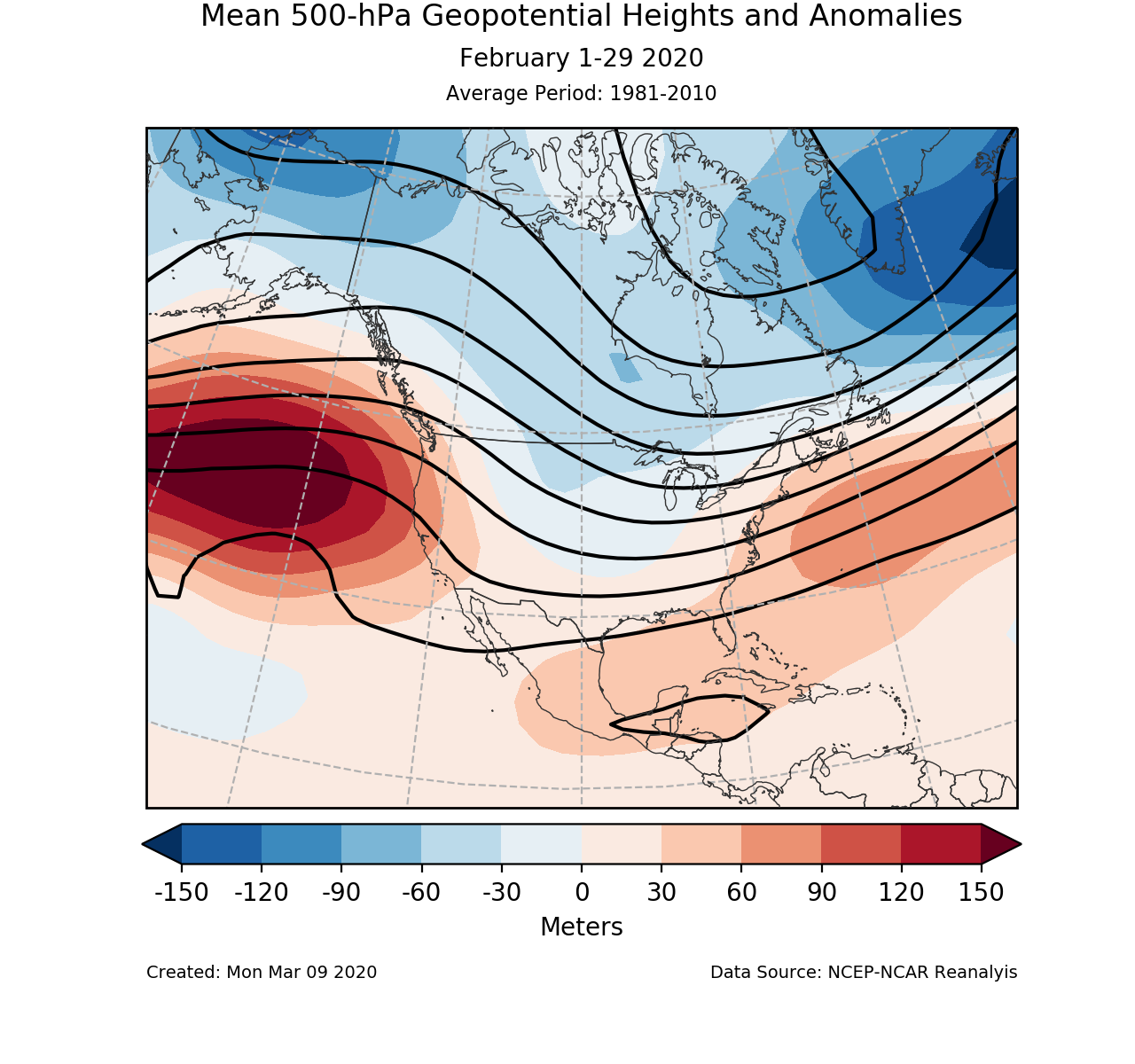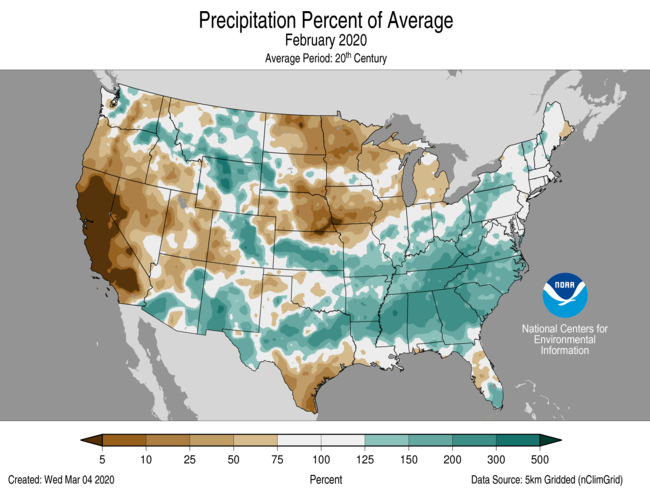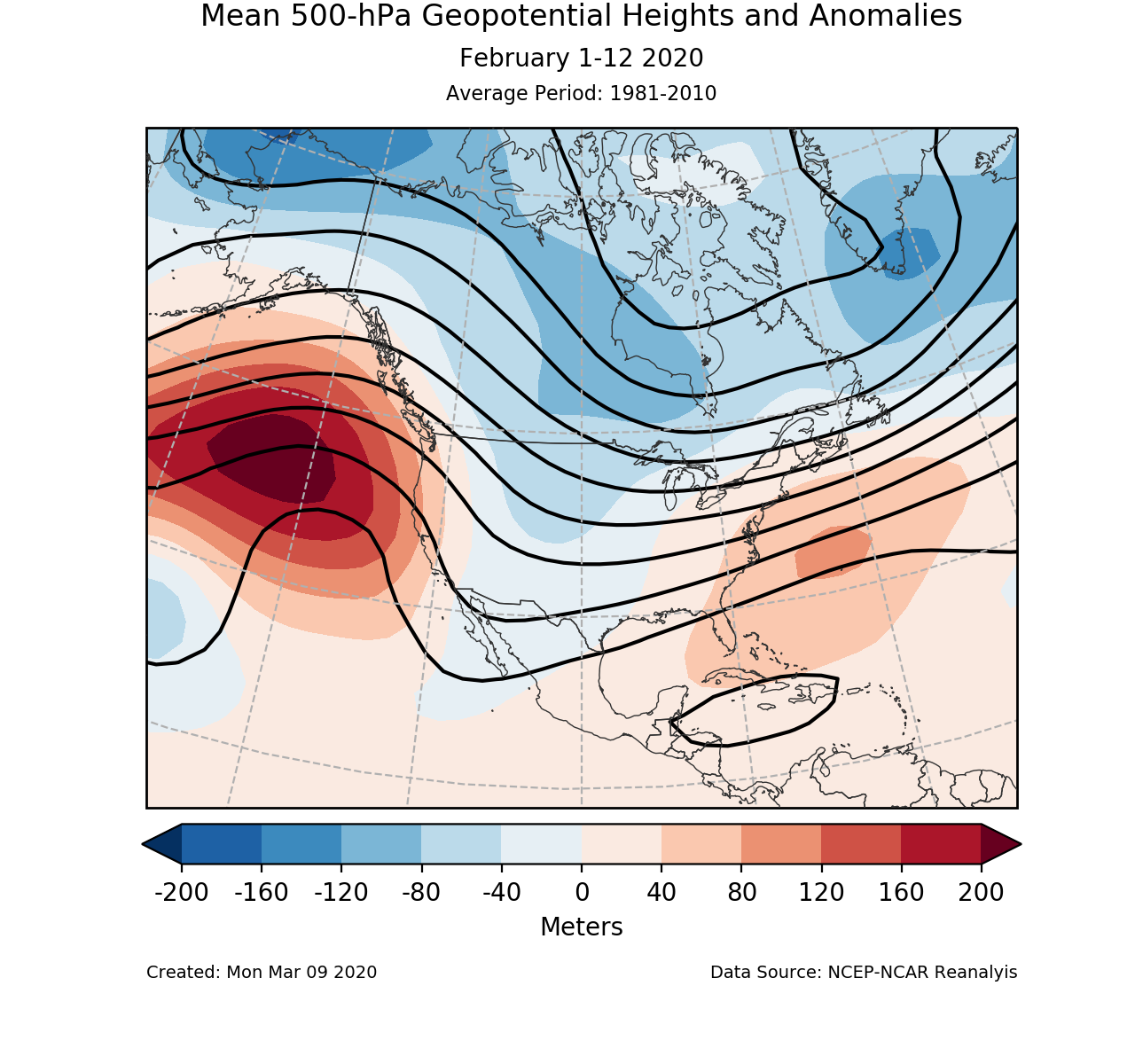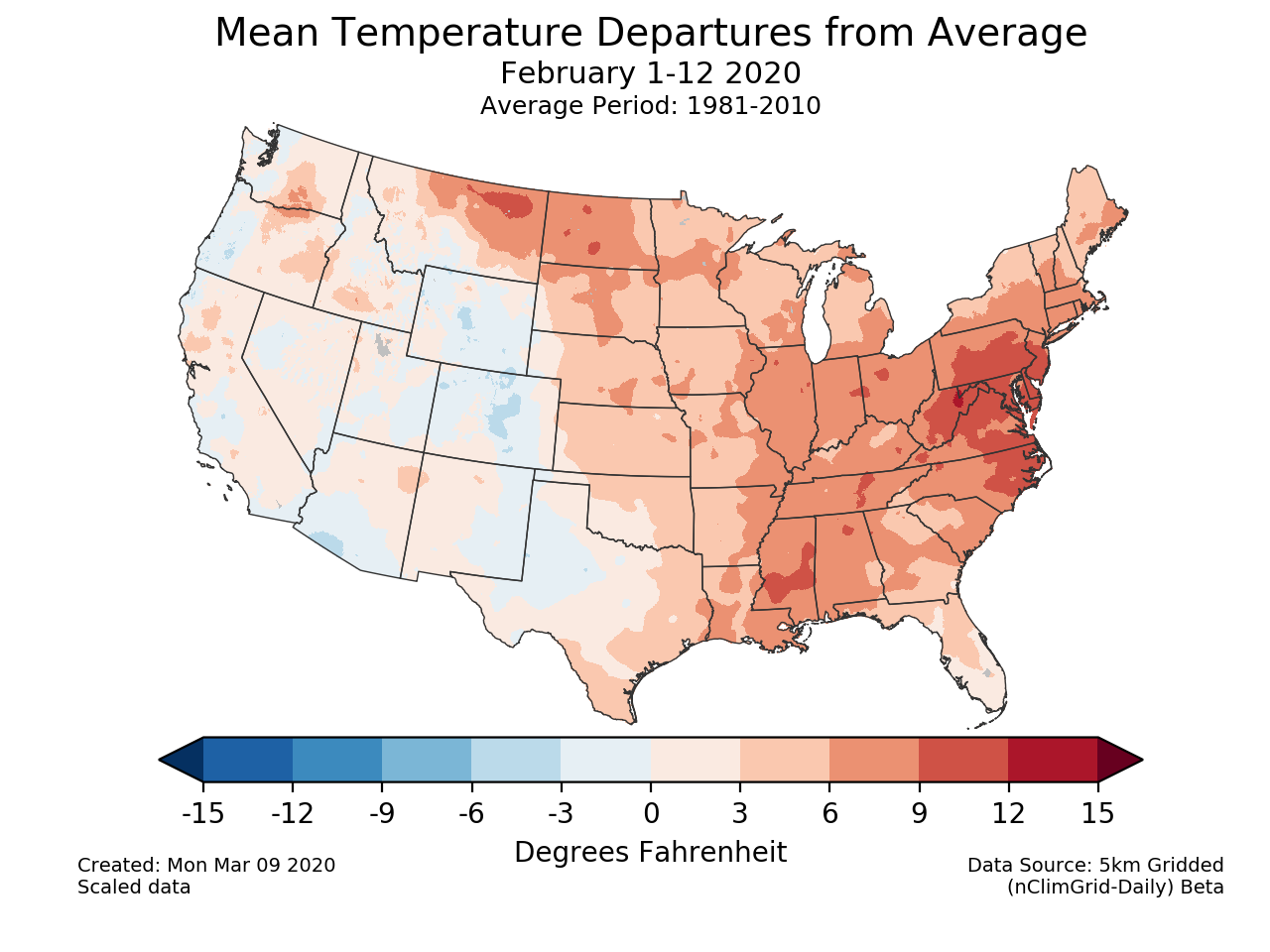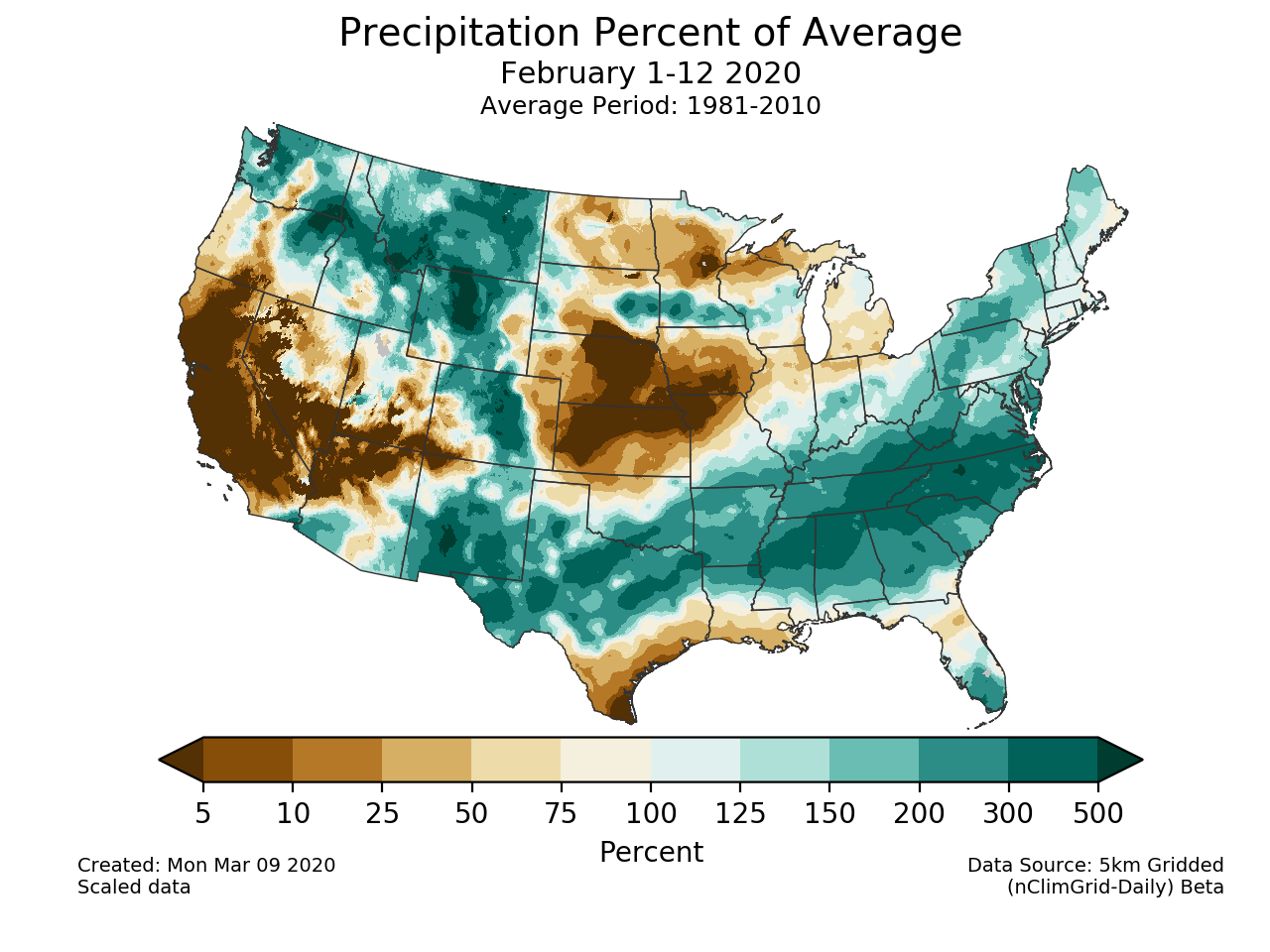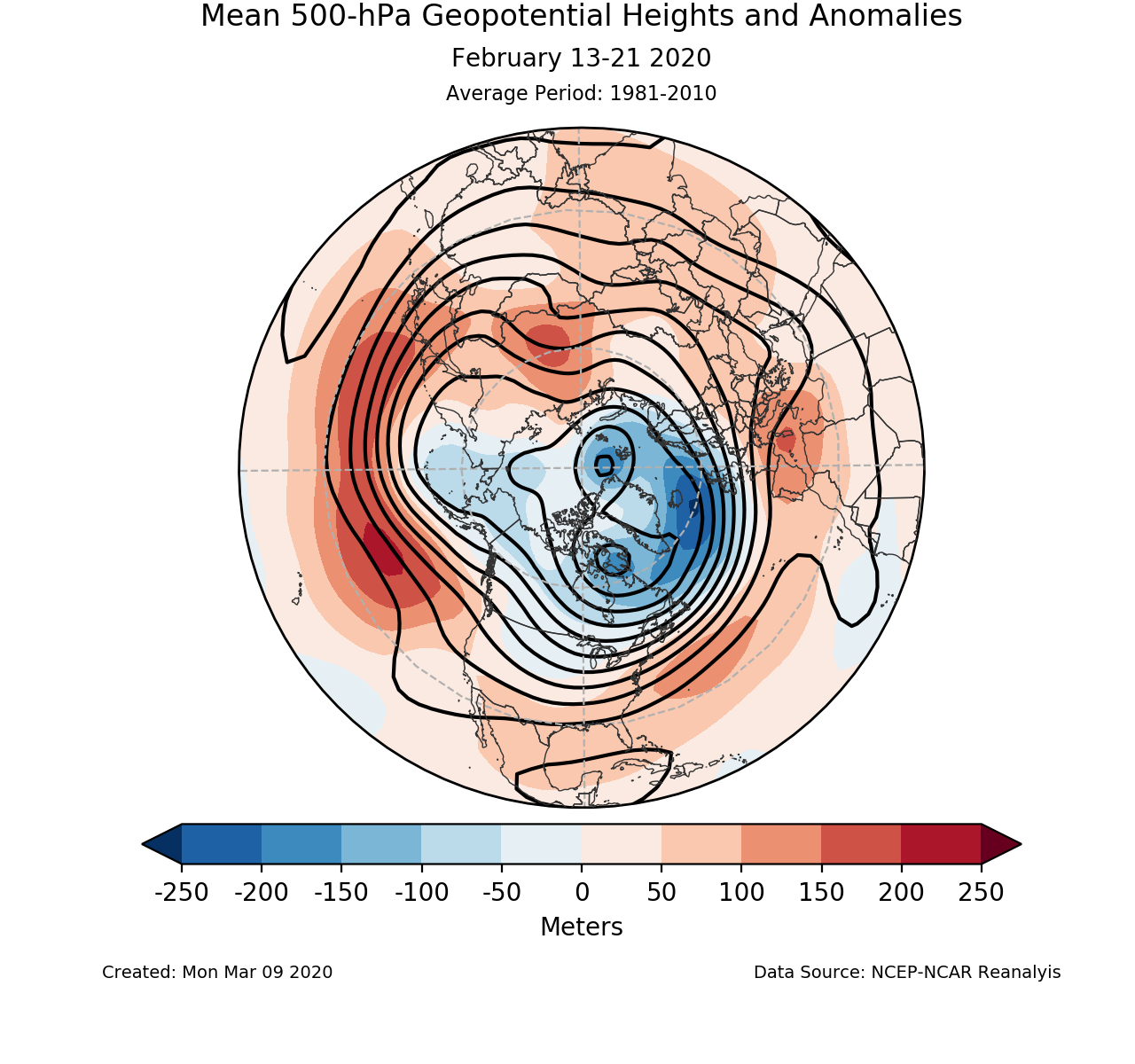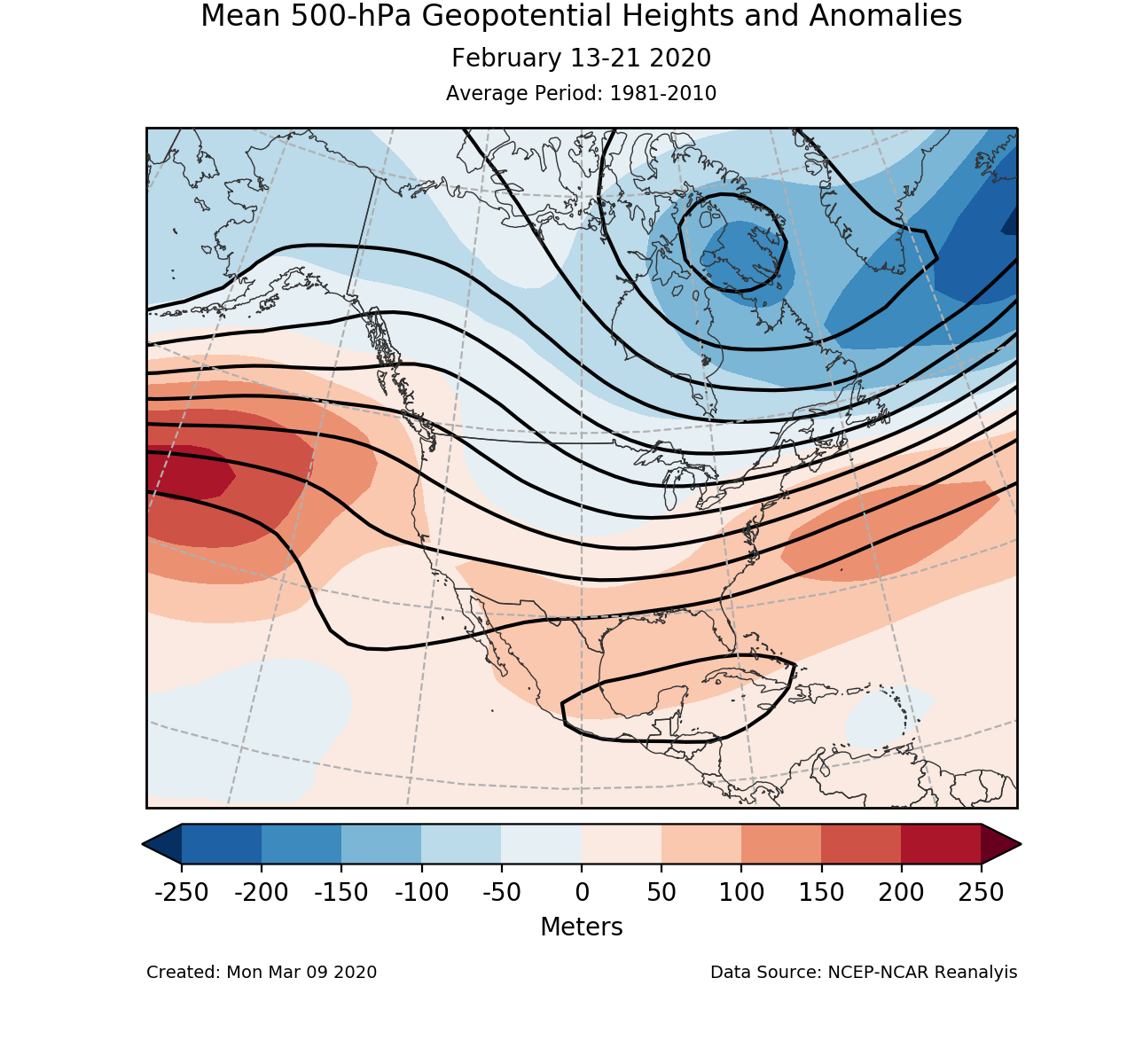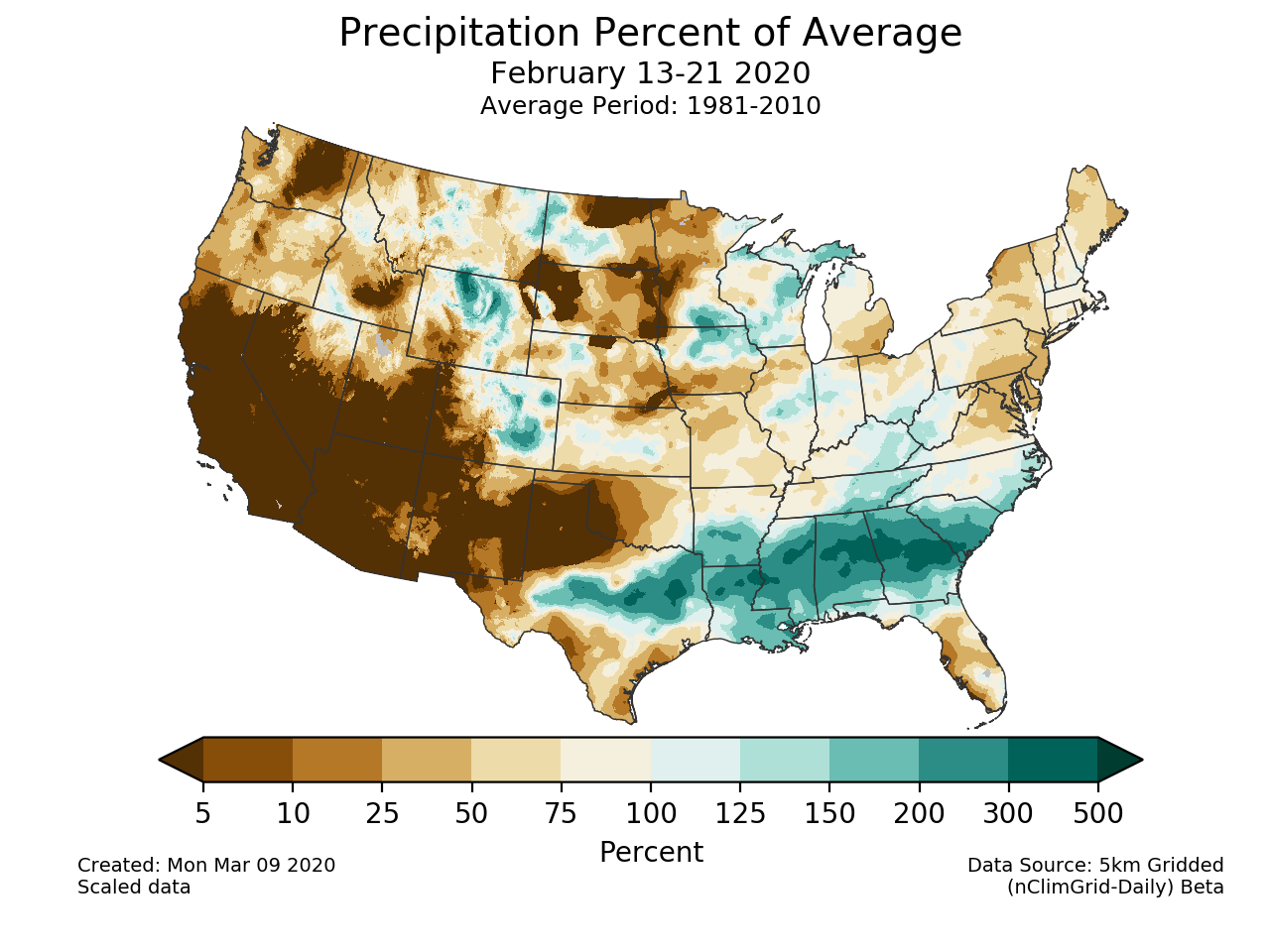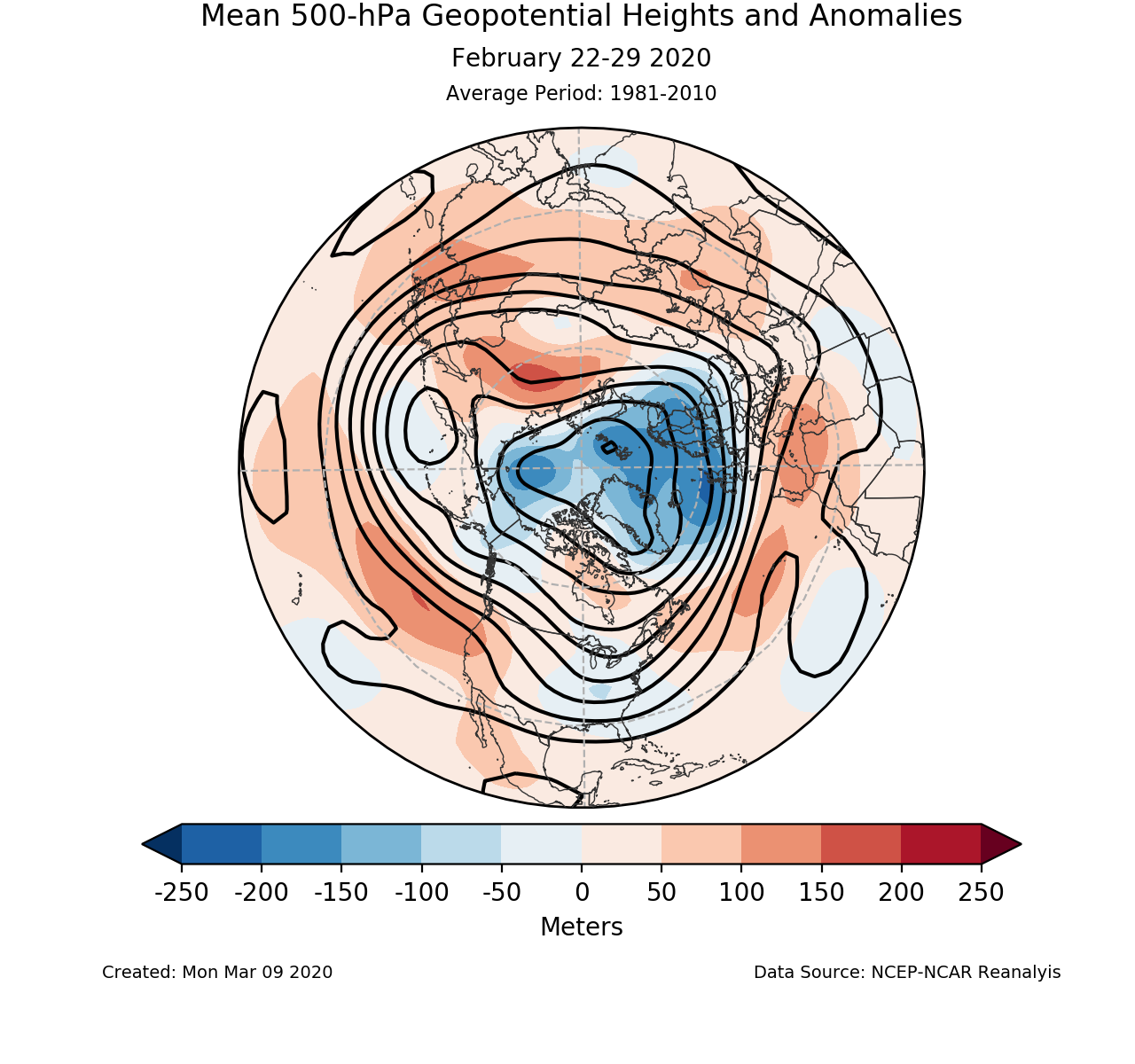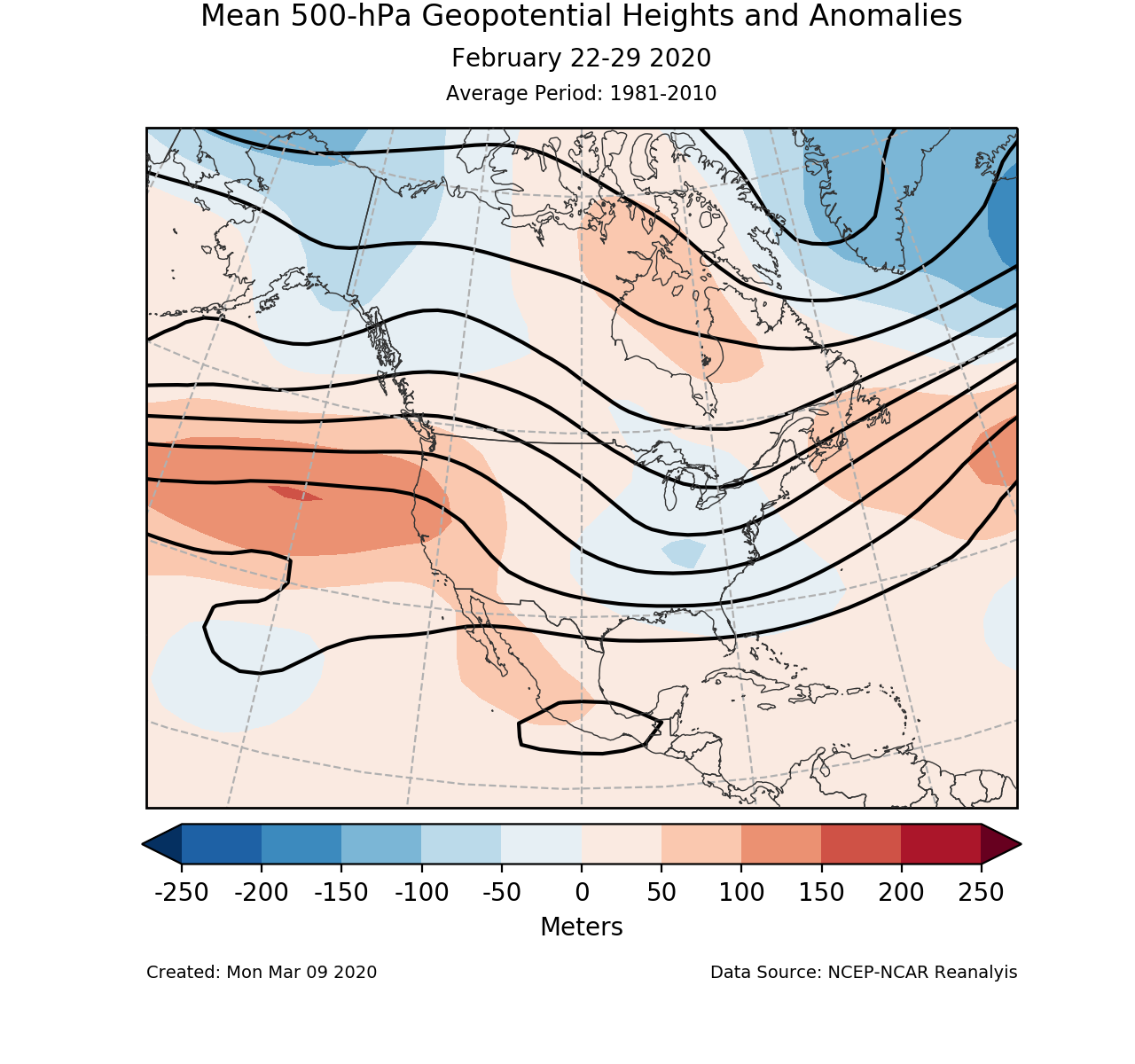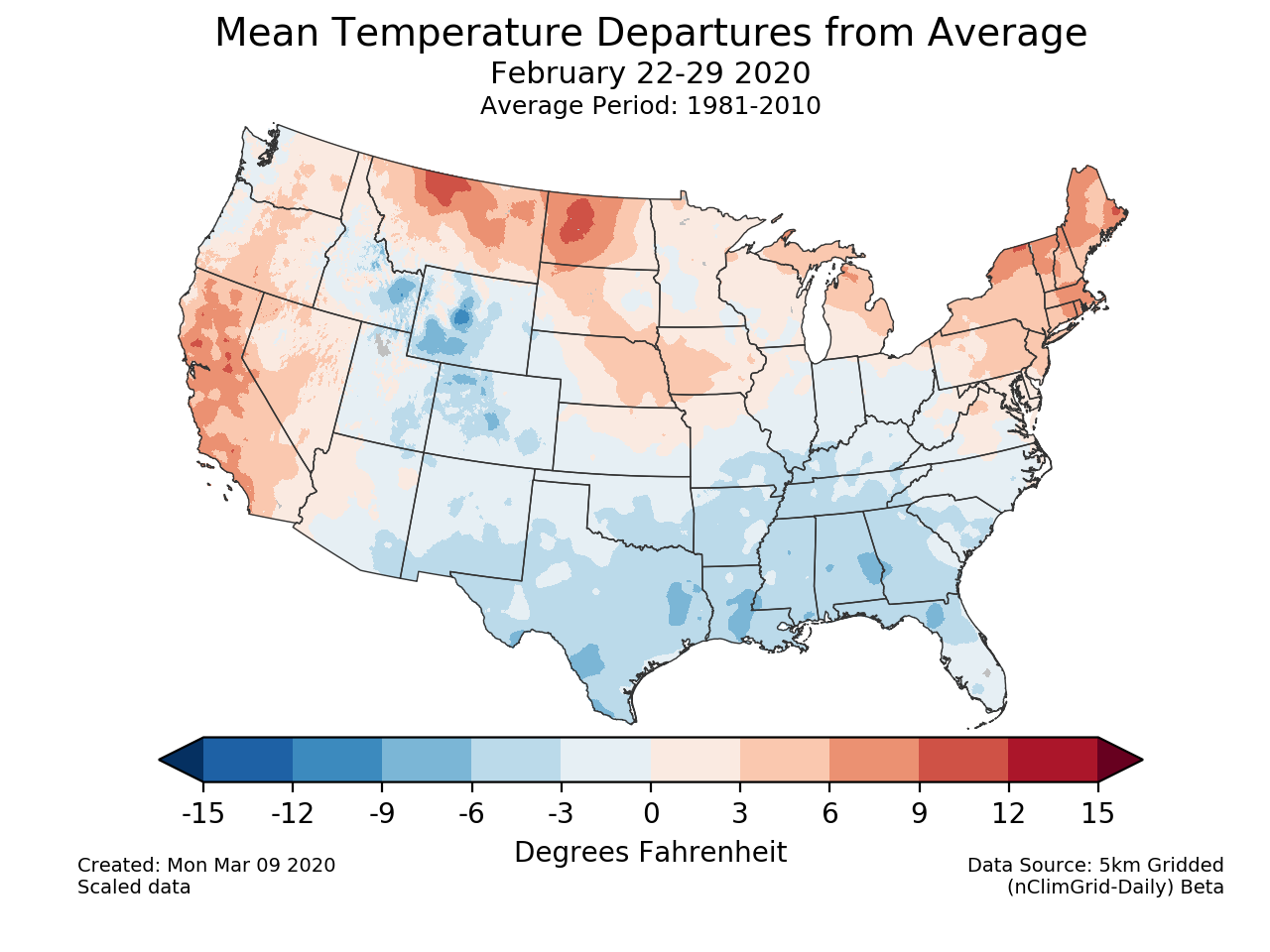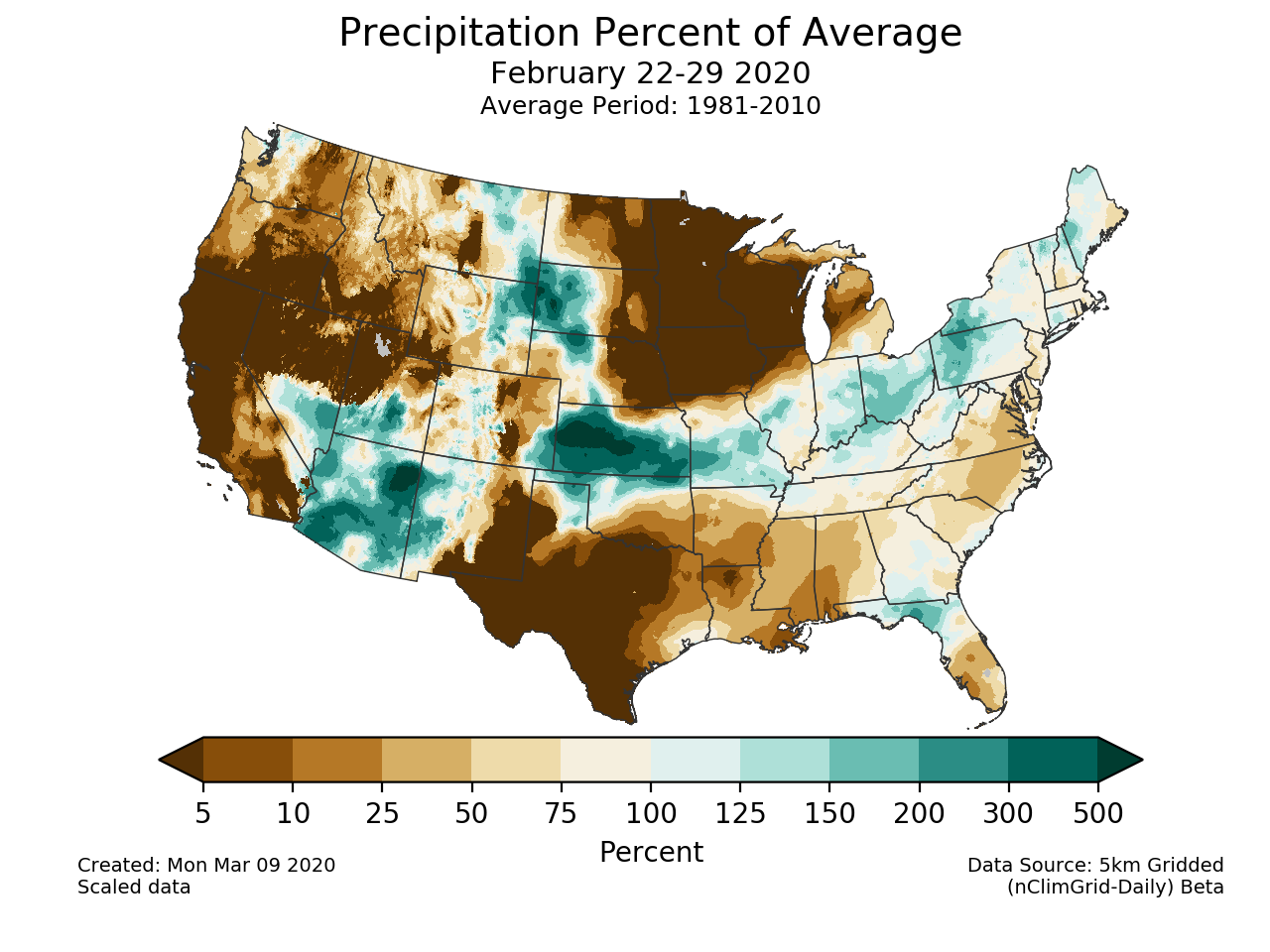Note: This Synoptic Discussion describes recent weather events and climate anomalies in relation to the phenomena that cause the weather. These phenomena include the jet stream, fronts and low pressure systems that bring precipitation, high pressure systems that bring dry weather, and the mechanisms which control these features — such as El Niño, La Niña, and other oceanic and atmospheric drivers (PNA, NAO, AO, and others). The report may contain more technical language than other components of the State of the Climate series.
Summary
| Time Period | Key Driver | Other Drivers |
|---|---|---|
| Month | AO+ |
EPO+, MJO |
| February 1-12 | AO+ |
EPO+, NAO+ |
| February 13-21 | AO+ | NAO+, Arctic air masses |
| February 22-29 | Shortwave Trough |
AO+ |
The biggest driver of the climate variability during February 2020 was a record-strong positive Arctic Oscillation (AO). Four of the five highest daily values on record since 1950 happened during February 2020. The only other day in that list was the previous all-time record-holder, February 26, 1990. The monthly AO in February 2020 was also the second-highest on record behind only January 1990. These strongly positive values were associated with a near-canonical circulation pattern that featured anomalous troughs over Greenland and the Chukchi Sea paired with anomalous ridges over western Europe and the Northeast Pacific.
A positive AO typically means a stronger circumpolar jet stream, which helps to confine cold arctic air near the pole. That pattern leads to warmer temperature in the midlatitudes. It probably contributed to Alaska experiencing its coldest February since 1999. In the midlatitudes, temperatures were much above normal over western Europe and eastern Asia. The signal was more mixed over the contiguous U.S. (CONUS). A positive AO is particularly associated with warmer than usual temperatures east of the Rockies. Those were primarily observed early in the month, but they were largely countered by a few cold air masses later in the month. Even so, the early warm anomalies strongly impacted the monthly averages in the Mid-Atlantic and southern New England where several states saw one of their top-10 warmest Februaries on record.
Another key driver was the positive East Pacific Oscillation (EPO), which was associated with a ridge off the West Coast and the trough near Alaska. The ridge played a major role in California experiencing its driest February on record as well as one of its 10 warmest. Meanwhile, the trough over the central U.S. led to a series of cold fronts that brought heavy rains and severe weather from Mississippi to North Carolina.
The last weather feature of note was a shortwave upper-level trough in the final week of February. This trough began on the southern side of the northeast Pacific ridge. It missed California but brought moisture to Arizona. As it moved northeastward, it brought a cold air mass to the southeast and sparked a major late-season lake-effect snowstorm for upstate New York.
Monthly Mean
Submonthly Evolution
February 1-12
February began with a typical positive AO pattern that featured an upper-level trough near the Great Plains and ridges near both coasts. In fact, the AO tied its all-time record high value on February 10, a record that would be broken less than two weeks later.
The East Coast ridge extended farther inland bringing warmer than normal temperatures to the eastern half of the country. Those anomalies were particularly strong in the Mid-Atlantic and southern New England. This early warmth drove the monthly averages in those regions with several states experiencing one of their top-10 warmest Februaries on record. The West Coast ridge created warm and dry conditions in California that would persist throughout the month.
The trough near the Plains did not contribute significant cold anomalies, but it did fuel some active weather patterns. A spring-like storm associated with this trough brought heavy snow to the southern Rockies February 4-6. An associated cold front led to severe weather and flooding from Alabama to North Carolina. This frontal zone in the Southeast would be a recurring feature during the month.
February 13-21
The trough near the Great Plains weakened somewhat during the middle of the month. However, a pair of arctic air masses brought cold anomalies east of the Rockies February 13-15 and again 19-22. Temperatures moderated during the interim, but these two air masses played a major role in limiting the warm anomalies for the month as a whole across much of the country. The air masses were particularly notable because they are less common during the positive phase of the AO, which set another record on February 21.
February 22-29
The ridge along the West Coast weakened somewhat near the end of February. A trough on its southern side brought moisture to Arizona, but it was too far south to affect California. East of the Rockies, the trough shifted farther south and brought a cold air outbreak to the Southeast in the final days of the month. The associated low-pressure system turned northward along the western slopes of the Appalachians. As it approached the northeast, it produced a remarkable late-season lake-effect snow event for upstate New York. The mild winter has left Lake Erie ice-free much later than normal, which provided ample fuel for the snow.
Atmospheric Drivers
ENSO: El Niño Southern Oscillation
- Description: Oceanic and atmospheric conditions in the tropical Pacific Ocean can influence weather across the globe. ENSO is characterized by two extreme modes: El Niño (warmer-than-normal sea surface temperature [SST] anomalies in the tropical Pacific) and La Niña (cooler-than-normal SST anomalies), with the absence of either of these modes termed “ENSO-neutral” conditions. These variations in SST change the locations of the Pacific's largest thunderstorms, which can in turn change circulation patterns around the globe.
- Status: The ocean and atmosphere system continued to be in ENSO-neutral during February 2020. The most common metric for ENSO is the SST anomalies in the Central Pacific, the Niño 3.4 region. These have been moderately warm since October after being near-zero in August and September. However, they have not been sustained for long enough to qualify as an El Niño and the atmospheric coupling is still lacking.
- Teleconnections (influence on weather): The teleconnections with ENSO are muted during near-neutral conditions. An active El Niño would have favored cooler and wetter than normal conditions in the Southeastern U.S. The Southeast did see above normal precipitation, but the temperatures were above normal in February 2020.
MJO: Madden-Julian Oscillation
- Description: The MJO is the biggest source of subseasonal (31-60 day) tropical variability. It typically develops as a large envelope of tropical thunderstorms that develops over the Indian Ocean that then moves eastward. Like ENSO, the MJO's effects on tropical rainfall is so strong that it can alter the atmospheric circulation around the globe. The thunderstorms decay when they cross the Pacific, but the associated winds can often continue across the Western Hemisphere to initiate the next MJO in the Indian Ocean. The MJO is episodic, meaning that is not always active. Most indices for tracking the MJO identify both the MJO's amplitude and the longitude of its strongest rainfall, usually described as one of eight phases.
- Status: The MJO was relatively weak during February. The most commonly used MJO index was stationary near the Maritime Continent (phase 5) for the first half of the month before showing a weak signal moving around the globe and ending the month over the Indian Ocean (phase 3). Upper-level velocity potential shows the MJO over the Indian Ocean at the beginning of the month, the Pacific in the middle of the month, and then over Africa near the end of the month.
- Teleconnections (influence on weather): The MJO's projection onto phase 5 (Maritime Continent) early in the month favored the warmer temperatures in the Eastern U.S. that transpired during February 1-12.
PNA: Pacific/North American pattern
- Description: The PNA teleconnection pattern is associated with strong fluctuations in the strength and location of the East Asian jet stream. PNA-related blocking of the jet stream flow in the Pacific can affect weather downstream over North America, especially the West and especially in the winter half of the year.
- Status: The daily PNA index near-zero for most of the month with brief periods of weak positive values around February 7 and 25. Averaged over the month, it was weak but positive during February 2020.
- Teleconnections (influence on weather): A positive PNA favors above-normal temperatures along the West Coast and cooler temperatures over the Southeast. That pattern was most apparent towards the end of the month. However, it would typically be coupled with above-normal temperatures in Alaska, which were not observed.
AO: Arctic Oscillation
- Description: The AO teleconnection pattern generally measures the pressure difference between the low pressure over the North Pole and the higher pressures in the subtropical ridges. This pressure difference is larger during a positive AO, resulting in a stronger midlatitude jet. When the AO is negative, the jet is weaker and will have larger troughs and ridges.
- Status: The daily AO was strongly positive throughout the month. February 10, 2020 tied the all-time record high positive AO from February 26, 1990. That record would be broken on February 21, 2020. The monthly average was also the second strongest on record behind only January 1993. The AO's strength was consistent with the near-canonical pattern of the observed circulation anomalies. These patterns included anomalous troughs near Greenland and the Chukchi Sea paired with anomalous ridges over western Europe and the Northeast Pacific.
- Teleconnections (influence on weather): The positive AO is associated with warmer than average temperatures over the Mississippi Valley, which were particularly prominent early in the month.
NAO: North Atlantic Oscillation
- Description: The NAO teleconnection pattern relates the pressure over the sub-polar low near Greenland and Iceland with the subtropical high over the Central Atlantic. It significantly affects the weather on both sides of the Atlantic.
- Status: The daily NAO was positive for most of February, and the monthly average was strongly positive. The positive NAO was largely due to the trough near Greenland along with ridge extending from western Europe across the North Atlantic.
- Teleconnections (influence on weather): The positive NAO would typically be associated with warmer temperatures over the Southeast, which were especially apparent in the early and middle parts of February.
WPO: West Pacific Oscillation
- Description: The WPO teleconnection pattern is a primary mode of low-frequency variability over the North Pacific and reflects zonal and meridional variations in the location and intensity of the East Asian jet stream in the western Pacific.
- Status: The daily WPO index was generally positive, particularly February 14-23. The monthly average was strongly positive. The strongly positive WPO in the middle of the month was primarily associated with ridge over Eastern Asia and the Central Pacific coupled with a trough in the Bering Sea. However, it lacked the typical trough over the western U.S., which may have limited its impacts.
- Teleconnections (influence on weather): The positive WPO is typically associated with warmer than normal temperatures over the Northern Plains, which were strongest early in the month when the WPO was weaker.
EPO: East Pacific Oscillation
- Description: The EPO pattern identifies variations in the strength and location of the eastern Pacific jet stream. During the positive phase, the jet is stronger and shifted southward. The negative phase is associated with an Alaskan ridge that weakens the jet. The EPO is closely related to the East Pacific–North Pacific (EP–NP) teleconnection pattern, although the two are defined with opposite signs.
- Status: The daily EPO index was moderately positive for most of the month. Averaged over February, the EPO was strongly positive with the anomalous trough near Alaska and the ridge in the northeast Pacific. Both features were shifted somewhat northward from the canonical EPO, which limited the index's amplitude somewhat.
- Teleconnections (influence on weather): The positive phase of the EPO favors warmer than normal temperatures across the Upper Midwest and Northeast. That pattern was most clear early in February when the ridge and trough were strongest. The ridge in the northeast Pacific also played a key role in the unusually dry conditions near California throughout the month.
 NOAA's National Centers for Environmental Information
NOAA's National Centers for Environmental Information
